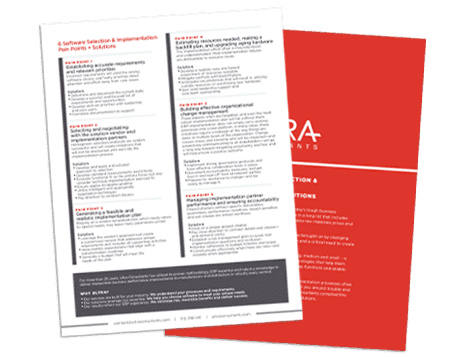Calculating ROI from ERP can be a significant challenge. As independent ERP consultants, we’re often asked about the concept of tracking ROI and inevitably the conversation leads to what returns to monitor.
Investment in ERP provides many opportunities for ROI calculation, both in estimating returns and calculating them, such as increased revenues, cost reductions, schedule performance, labor efficiency improvements, and quality improvements.

ROI can be measured by increased revenues, cost reductions, efficiency improvements, quality improvements to name a few.
3 Steps to Assessing ROI
Calculating ROI from an investment in ERP involves a three-part approach. To be most successful at managing changes to their business processes, companies need to:
- Make ROI calculations standard operating procedure in order to both justify projects and evaluate them upon completion
- Include all associated costs in your ROI calculations including internal staffing costs.
- Eliminate dependency on pens, pencils and spreadsheets. Utilize reporting capabilities of the system and supplement them with integrated business intelligence and event management for real time performance monitoring
Without pre-defining the important metrics to be improved by the significant investment of implementing a new or upgraded ERP system, it will be difficult to determine if the investment was worthwhile.
It will also be difficult to identify areas that must be addressed in order to achieve the desired results or to know what is working well.
Defining the business case as part of the ERP system selection process will provide information for:
- Making a good selection of an ERP system
- Aligning the implementation project and business transformation with the lifelines of the business
- Monitoring the business as the implementation project moves through its phases
- Defining the benchmarks of performance after implementation
Build the Business Case
In building such a business case, we look as various business metrics that include (but not necessarily limited to):
- Acquire New Customers
- Retain and Grow Current Customers
- Leverage Income-generating Assets
- Strengthen Pricing
- Variable Cost Productivity
- Fixed Cost Productivity
- Purchase Price Deflation
- Improvements in
- Customer Interaction Efficiency
- Corporate Shared Service Efficiency
- Development and Production Efficiency
- Logisitics and Service Position Efficiency
- Income Tax Efficiency
- PP&E Efficiency
- Inventory Efficiency
- Payables and Receivables Efficiency
- Managerial and Governance Effectiveness
- Execution Capabilities
The Value Map
Once this business case is developed, an Enterprise Value Map can be used to represent the case.
A typical map would include reports/graphs to support the details before and after implementation.
The map is just one supporting document to build the business case as part of the business analysis process.
By taking this approach, the selection and implementation teams know how to orient their thinking and decision making so that the strategic lifelines of the business are improved. If they are not, correction actions can be well defined.
Calculating ROI from your Investment in ERP? Learn More
As an independent ERP consultant firm, Ultra’s mission is to help manufacturers and distributors achieve the full advantage of technology tools and processes. Our goal is to maximize the ROI of your investment. Contact us today for your free discovery call and let us help ensure your next ERP delivers real results.
6 Software Selection & Implementation Pain Points + Solutions
Software selection and implementation processes often present challenges of their own. To steer you around trouble and help you drive success, Ultra’s experts compiled a list of pain points and solutions to be aware of as you embark on this journey.

Table of Contents
More ERP material...
The Undeniable Benefits of Implementing ERP in Food and Beverage Manufacturing
Data analytics holds the ability to highlight inefficient manufacturing processes and enable…
Emerging Technologies in Manufacturing Driving Business Growth
Data analytics holds the ability to highlight inefficient manufacturing processes and enable…
How Food Production ERP Improves Manufacturing Efficiency
Data analytics holds the ability to highlight inefficient manufacturing processes and enable…



